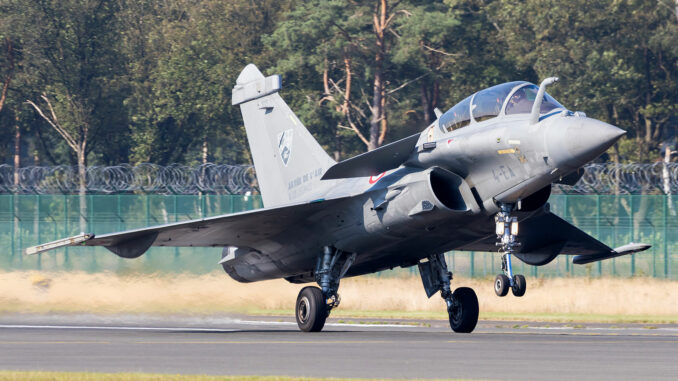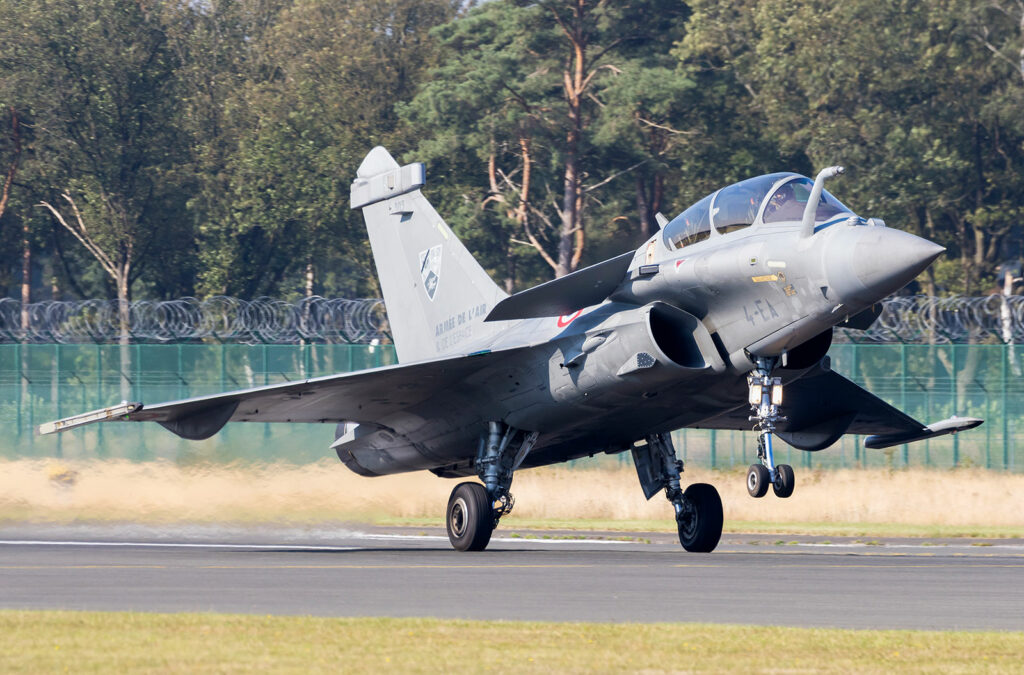
Comprehensive analysis of the Rafale compared to the F-35, Typhoon, and Gripen: costs, range, strategy, maintenance, and buyer countries over 30 years.
An aircraft at the heart of geopolitical choices
The Dassault Rafale is a 4.5-generation multirole fighter aircraft capable of performing ground attack, interception, reconnaissance, and nuclear deterrence missions. It entered service in 2001 and has gradually gained a significant share of the export market, with more than 300 aircraft ordered abroad (Egypt, India, Qatar, Greece, Croatia, and the United Arab Emirates). Its main advantage is that it combines operational versatility, industrial independence, and integration flexibility.
Internationally, it faces several direct competitors. The Lockheed Martin F-35 (United States) is a fifth-generation stealth aircraft focused on technological superiority and NATO integration. The Eurofighter Typhoon, designed in European cooperation, focuses on air superiority. The Saab Gripen E (Sweden) aims to strike a balance between moderate cost, interoperability, and modern technology.
Between technical performance, budget constraints, and sovereignty issues, the purchase of the Rafale raises complex questions for the purchasing countries.

Rafale vs F-35: technologies, doctrines, NATO compatibility
In terms of technology, the Rafale and F-35 have very different philosophies. The Rafale is a 4.5-generation aircraft, not stealthy in its structural design, but equipped with devices that reduce its radar and infrared signature. It incorporates the AESA RBE2-AA active antenna radar, the SPECTRA electronic warfare system, and an OSF optronic suite for passive detection. The F-35 Lightning II, on the other hand, is a fifth-generation fighter, designed from the outset for radar and thermal stealth. It is equipped with an AN/APG-81 radar, an advanced DAS/AN/ASQ-239 electronic warfare system, and multi-source data fusion thanks to its “glass” cockpit and Helmet Mounted Display system.
The Rafale’s doctrine of use is based on real versatility: it can switch from an air superiority mission to a nuclear strike or ground support without any major configuration changes. This approach meets the needs of an air force that has to adapt to various scenarios with a reduced fleet. The F-35, on the other hand, is designed for network-centric warfare. It is designed to operate in constant interconnection with other platforms in a digitized and coordinated environment. This approach requires a comprehensive infrastructure that is dependent on US standards and systems.
In terms of NATO interoperability, the F-35 is fully aligned with US standards. It is optimized for real-time data exchange with other allied systems, but remains heavily dependent on Lockheed Martin’s logistical support (software updates, centralized ALIS/ODIN maintenance chain). The Rafale is interoperable with NATO systems while allowing significant national flexibility, notably thanks to its ability to integrate non-standard weapons (such as the Meteor missile or the SCALP) and to be operated without total technical dependence on an external partner.
Technological sovereignty: a diplomatic lever?
One of the major arguments in favor of the Rafale is its ability to guarantee a certain degree of strategic autonomy to the countries that purchase it. The manufacturer, Dassault Aviation, offers extensive technology transfer options, including the possibility of partial or complete local production, as negotiated with India. This type of agreement allows countries to develop their aerospace industry, control part of the supply chain, and ensure independent maintenance, even in the event of diplomatic tensions. The Rafale is also designed to be operated without absolute dependence on a single supplier for software updates or the integration of new weapons.
Conversely, the F-35 is subject to centralized control by the United States. Although some partner nations in the program (such as the United Kingdom and Italy) are involved in manufacturing, software management is exclusively handled by Lockheed Martin. All operational data, maintenance diagnostics, and updates pass through the ODIN system (formerly ALIS), which is entirely administered by the US manufacturer. This severely limits user independence, particularly in the choice of weapons or modification of onboard systems. In addition, some contracts include restrictions on the use and transfer of information, making secondary export or independent use more complex.
Concrete examples illustrate this distinction. India, with its contract for 36 Rafales, demanded industrial compensation and entered into discussions for local assembly. Egypt and the United Arab Emirates obtained relative freedom to use and integrate non-US weapons. In contrast, Indonesia, initially interested in the F-35, turned to the Rafale, partly to avoid the contractual constraints and strategic dependence associated with the US aircraft.
Total costs over 30 years: purchase, maintenance, training, infrastructure
A 30-year cost analysis highlights significant differences between the Rafale and the F-35, beyond the initial purchase price. The unit cost of a Rafale for export is estimated at between $100 million and $120 million, including the aircraft, basic weapons, logistical support, and initial training. The F-35A, in its basic configuration, is priced at around $90 to $100 million, but this price does not include customized weapon options, software costs, or long-term maintenance costs.
In operational terms, costs per flight hour vary greatly. The Rafale is estimated at between €14,000 and €17,000 per flight hour, depending on the configuration and the country of use. The F-35 exceeds $30,000 per flight hour (approximately $33,000), mainly due to the complexity of its onboard systems and the specific logistics required for its maintenance. This difference has a significant impact on the overall budget of air forces, especially for fleets of 30 or more aircraft.
The predictive maintenance of the Rafale can be carried out locally thanks to skills transfer agreements. Conversely, the F-35 requires specific infrastructure: temperature-controlled hangars, digital tools connected to the ODIN system, and access to a global network of spare parts under US control. This forces user countries to adapt their air bases to precise technical standards, which are often costly.
Finally, the hidden costs of the F-35 include recurring software updates, dependence on a closed supply chain, and the cost of ongoing training on evolving systems. In the long term, these factors can represent up to 60% of the total cost of the program over 30 years, making the aircraft significantly more expensive than its initial price suggests.

The human factor: feedback from air forces
Pilot feedback is an often underestimated factor in the evaluation of a fighter jet. Regarding the Rafale, feedback from foreign air forces has been generally positive. In Egypt, the Rafale has been engaged since 2015 in ground strike operations against armed groups in Libya and the Sinai Peninsula. Egyptian pilots have praised the reliability of the SPECTRA system, the accuracy of strikes with the SCALP missile, and the ability to operate in environments without air superiority.
In India, the 36 Rafales delivered to the Ambala base were quickly integrated. Indian pilots highlight the versatility of the aircraft, its ability to engage multiple targets simultaneously, and the effectiveness of the Meteor air-to-air missile. In Qatar, the experience is similar, particularly for long missions over the Arabian Peninsula, thanks to the aircraft’s long range and in-flight refueling system.
In contrast, users of the F-35 are experiencing persistent availability issues. In the United States, Canada, and some European countries, the operational availability rate is often below 60%. Recurring software bugs, particularly related to data fusion and ODIN diagnostic systems, complicate maintenance and delay some missions. Several reports by the US Government Accountability Office (GAO) have highlighted recurring failures in software updates and maintenance.
In terms of training, the Rafale is designed for a rapid transition from a previous aircraft, with a well-hierarchized “glass” cockpit interface. The F-35 requires longer training, as the entire interface is integrated into the helmet and involves more complex networked warfare logic. This difference has a direct impact on initial and ongoing training costs, as well as on the ease of adoption by pilots from different backgrounds.
A strategic choice rather than a purely technical one
The purchase of a fighter jet is not limited to a technical or financial comparison. It is a major strategic decision, influenced by alliances, geopolitical interests, and international power relations. In this context, the role of the United States is decisive. Washington exercises structural influence over international military contracts, notably through the ITAR (International Traffic in Arms Regulations) rules, which impose strict conditions on the use, resale, or modification of US equipment. This influence translates into indirect blocking power over certain military capabilities if a country acquires equipment such as the F-35. It also requires constant diplomatic vigilance, as a deterioration in bilateral relations can impact the operational maintenance of the aircraft.
In response to this, the Rafale represents an alternative offering greater strategic autonomy. It is entirely designed, produced, and maintained outside US channels. This allows client states to control their supply chains, negotiate technology transfers, and even assemble certain parts locally. The Rafale can also integrate non-NATO weapons, such as local or third-party missiles, which broadens its field of use without direct political dependence.
In the event of diplomatic tensions, this independence becomes a decisive operational advantage. A country operating F-35s may find itself without access to spare parts, software updates, or even facing restrictions on use. In comparison, the Rafale can continue to be supported through sovereign or European channels, as demonstrated by the cases of Egypt and India. The choice of the Rafale therefore commits states not only on a military level, but also in terms of their ability to preserve their freedom of action in an unstable international environment.
Balancing power, independence, and economic viability
The Rafale is not only impressive for its technical characteristics. It is part of a broader approach, where national strategy, operational autonomy, and stable diplomatic relations are as crucial as stealth or radar power. Unlike the F-35, which is designed for networked warfare under US supervision, the Rafale offers flexibility of use, controlled interoperability and extended access to maintenance and on-board systems.
The decisive criteria in a purchase are therefore not limited to a comparison of sensors or missile ranges. It is also necessary to consider the cost of ownership over 30 years, the ability to train pilots, the freedom to integrate weapons and the level of logistical dependence. Added to these factors are the risks associated with ITAR restrictions, software updates, or interruption of support for political reasons.
Each country defines its own equation, based on its budgetary capabilities, strategic objectives, and military doctrine. For some, the F-35 may be the right choice for NATO integration. For others, the Rafale represents a balanced option, combining performance, independence, and long-term economic viability.
War Wings Daily is an independant magazine.